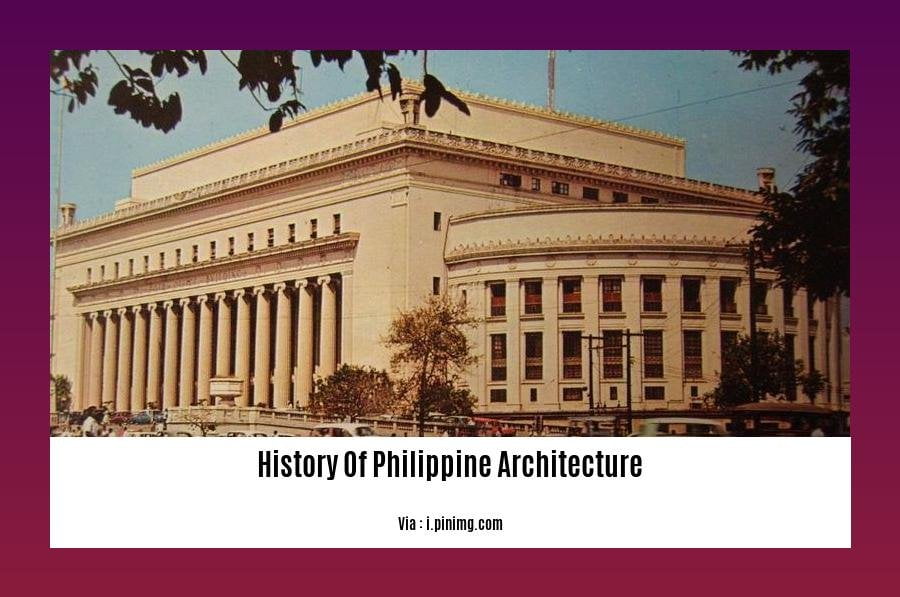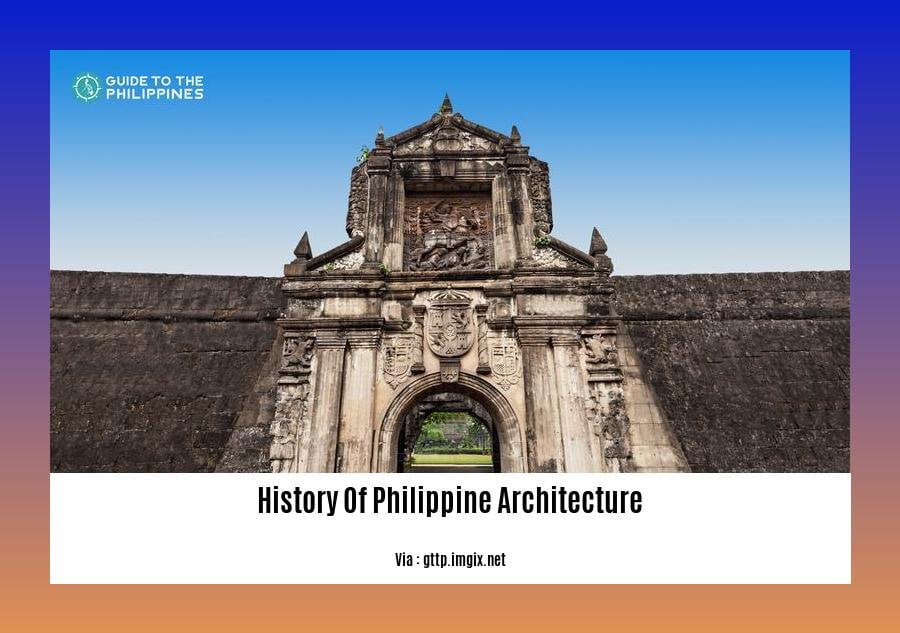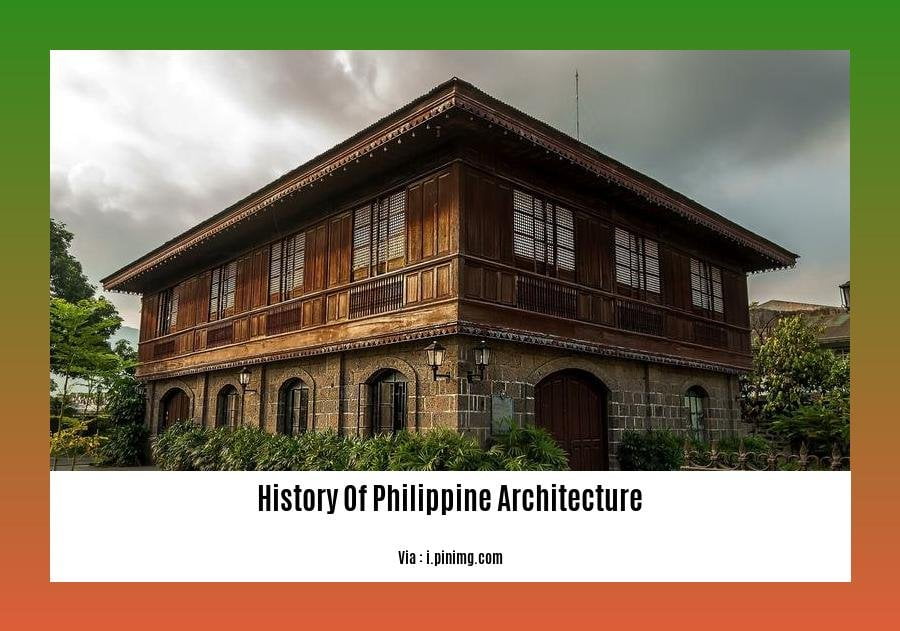Journey through the fascinating history of Philippine architecture as we delve into its rich narratives and diverse influences. From the grandeur of pre-colonial structures to the evolution of contemporary designs, discover the stories behind the country’s built treasures through the eyes of an experienced architectural historian. Uncover the unique blend of local and global influences that shaped Philippine architecture, leaving an indelible mark on its cultural landscape.
Key Takeaways:
Philippine architecture has a rich history that can be traced through five distinct periods.
The Pre-Hispanic Era is marked by rock shelters and caves, while the Spanish Colonial Era introduced the Antillean style.
The American and Japanese Era brought a mix of architectural influences, leading to multi-storey buildings with central courtyards.
The Late Twentieth Century witnessed experimentation and innovation, with the rise of modern and contemporary styles.
The New Millennium has seen a focus on sustainability, cultural preservation, and the integration of new technologies in architecture.
Various architectural landmarks have emerged throughout these periods, showcasing a diverse array of architectural styles.
History of Philippine Architecture

The Philippines has a rich and diverse architectural history that spans five distinct periods. Let’s dive into each era and explore the unique architectural styles that emerged during these times.
Pre-Hispanic Era
The earliest evidence of architecture in the Philippines can be traced back to the Pre-Hispanic Era. During this period, rock shelters and caves in Palawan served as dwellings for early Filipinos. These structures showcase the ingenuity and adaptability of our ancestors, who utilized natural resources to create functional living spaces.
Spanish Colonial Era
The arrival of the Spanish colonizers in the 16th century marked a significant turning point in Philippine architecture. The Spaniards introduced the Antillean style, characterized by stone fortifications, churches, and government buildings. Intricate carvings and religious motifs adorned these structures, reflecting the fusion of European aesthetics with local craftsmanship.
American and Japanese Era
The American and Japanese Era brought about a shift in architectural styles. Multi-storey buildings with central courtyards emerged, blending American and Japanese influences. Art Deco elements, such as geometric patterns and stylized ornamentation, became prominent during this period.
Late Twentieth Century
The Late Twentieth Century witnessed a surge of architectural experimentation and innovation. Modern and contemporary architectural styles gained prominence, characterized by clean lines, functional design, and the use of new materials and technologies. Iconic structures like the Cultural Center of the Philippines and the Coconut Palace epitomize this era of architectural evolution.
New Millennium
The New Millennium has seen a continued development of Philippine architecture, with a focus on sustainability, cultural preservation, and the integration of new technologies. Green building practices, adaptive reuse of heritage structures, and the use of indigenous materials have become increasingly prevalent. Architectural landmarks like the Ayala Museum and the Bonifacio Global City showcase this commitment to innovation and sustainability.
Each period in Philippine architectural history has left an indelible mark on the country’s built environment. From the simplicity of pre-colonial dwellings to the grandeur of Spanish colonial churches, and the modern marvels of the 21st century, Philippine architecture continues to evolve and reflect the nation’s rich cultural heritage and dynamic identity.
Curious about how the oil and gas industry emerged in Nigeria? Embark on a captivating journey through our rich history, discovering how it all began and how it has shaped the nation. history of oil and gas in nigeria
American Period – Art Deco and Neoclassical Influences, Rise of Modern Architecture
The American Period (1898-1946) marked a significant turning point in Philippine architecture, characterized by the fusion of American and Filipino influences. This era witnessed the rise of Art Deco and Neoclassical architectural styles, paving the way for the emergence of modern architecture in the country.
The Fusion of American and Filipino Influences
The American colonial government introduced new architectural concepts and techniques that blended with existing Filipino traditions, resulting in a unique architectural style. American architects and engineers collaborated with local craftsmen to create buildings that reflected both cultures.
The Rise of Art Deco and Neoclassical Styles
Art Deco, a style that originated in the 1920s, made its way to the Philippines during the American period. Characterized by its geometric forms, streamlined shapes, and decorative details, Art Deco became a popular choice for commercial and government buildings. Notable examples include the Manila City Hall, the Legislative Building, and the Metropolitan Theater.
Neoclassicism, a revival of classical Greek and Roman architectural elements, also gained prominence during this time. Neoclassical buildings featured symmetrical facades, columns, and pediments, often adorned with intricate carvings and sculptures. Examples include the National Museum of the Philippines and the Manila Central Post Office.
The Emergence of Modern Architecture
In the late 19th century, modern architecture began to take shape in the Philippines. Modernist architects rejected the ornate and decorative styles of the past, favoring clean lines, functional design, and the use of new materials such as steel, glass, and concrete. The emergence of modern architecture marked a departure from traditional styles and heralded the beginning of a new era in Philippine architecture.
Key Takeaways:
- The American Period brought a fusion of American and Filipino architectural influences.
- Art Deco and Neoclassical styles gained popularity during this time, shaping the landscape of Philippine architecture.
- The rise of modern architecture marked a shift towards functional design and the use of new materials.
- American architects and engineers collaborated with local craftsmen to create unique and iconic structures.
Sources:
Art Deco Architecture in the Philippines
Modern Architecture in the Philippines
Post-War Period – reconstruction and emergence of national identity in architecture

The post-war period in the Philippines marked a time of remarkable transformation and rebuilding. Architecture played a pivotal role in this era, serving as a means of expressing a newly independent nation’s identity and fostering a sense of national pride.
Modernism took center stage, with its emphasis on functionality, simplicity, and the use of concrete, glass, and steel. Architects embraced straight lines, geometric forms, and open spaces, creating buildings that symbolized the country’s progressive outlook and desire for a fresh start.
One of the key features of post-war architecture was the incorporation of Filipino motifs and elements. Traditional materials like bamboo and capiz shells were integrated into modern designs, creating a unique blend of international styles and local heritage. This fusion of the old and the new reflected the nation’s aspiration to blend tradition with modernity.
The post-war period also saw the rise of Filipino architects who contributed significantly to the development of a distinct national architectural style. Among them were Leandro Locsin, Carlos Arguelles, and Jose Maria Zaragoza. These architects drew inspiration from the country’s history, culture, and natural environment, creating buildings that embodied the Filipino spirit.
Key Takeaways:
- The post-war period in the Philippines witnessed the emergence of modernism in architecture, characterized by simplicity, functionality, and the use of concrete, glass, and steel.
- Architecture served as a powerful tool in expressing the nation’s newfound identity and fostering a sense of national pride.
- Filipino motifs and elements were incorporated into modern designs, resulting in a unique blend of international styles and local heritage.
- Filipino architects played a crucial role in shaping the country’s post-war architectural landscape, creating buildings that reflected the Filipino spirit and showcased the nation’s rich history and culture.
Citations:
[1] “Methods, Techniques and Approaches to Post-War Architectural Reconstruction” by Antonio Paulo Requilme_Salas, 2019,
[2] “Philippine Architecture during the Post-War Period” by Ar. Gerard Lico, 2011,
Contemporary Period – Globalization, Sustainable Design, and the Influence of International Architects
In the realm of Philippine architecture, the contemporary period stands as a vibrant showcase of globalization’s impact, sustainable design principles, and the profound influence of international architects. This era has witnessed a remarkable convergence of global trends and local expressions, shaping the country’s built environment in unprecedented ways.
Globalization: A Catalyst for Architectural Convergence
Globalization, fueled by technological advancements, has transformed the world into an interconnected web, where ideas, trends, and designs seamlessly flow across borders. This phenomenon has had a profound impact on architecture, leading to the spread of international styles and the homogenization of local traditions.
The Culture of Commerce: A Driving Force for Standardization
Globalization’s relentless pursuit of economic efficiency has given rise to the culture of commerce, which has significantly shaped contemporary architecture. This culture prioritizes cost-effectiveness, standardization, and mass production, resulting in the replication of similar designs worldwide.
The Culture of Design: Embracing Innovation and Exchange
Complementing the culture of commerce is the culture of design, which celebrates the exchange of ideas, innovation, and the quest for unique architectural expressions. This culture has facilitated the cross-pollination of design concepts, leading to a global melting pot of architectural styles.
Sustainable Design: A Response to Environmental Imperatives
In response to growing environmental concerns, sustainable design has emerged as a guiding principle for contemporary architecture. Architects are increasingly embracing green building practices, incorporating energy-efficient technologies, utilizing renewable resources, and minimizing carbon emissions.
Embracing Vernacular Wisdom
Sustainability in Philippine architecture often draws inspiration from vernacular traditions, where indigenous materials and construction techniques are employed to create climate-responsive and environmentally friendly structures.
International Collaborations: Fusing Global Expertise
International collaborations have played a pivotal role in advancing sustainable design in the Philippines. Architects from various countries bring their expertise and insights, fostering knowledge exchange and the development of innovative sustainable solutions.
International Architects: Shaping the Philippine Skyline
The influence of international architects has left an indelible mark on the Philippine cityscape. Renowned architects from around the world have graced the country with iconic structures that reflect their unique design sensibilities and global perspectives.
Zaha Hadid: A Master of Deconstructivism
The late Zaha Hadid, known for her groundbreaking deconstructivist style, left her imprint on the Philippines with the Makati Diamond Residences. This striking skyscraper, with its dynamic curves and fragmented forms, embodies Hadid’s signature aesthetic.
Kengo Kuma: A Champion of Natural Materials
Japanese architect Kengo Kuma has made a name for himself through his innovative use of natural materials. His Manila office for fashion brand Uniqlo showcases his signature style, featuring a façade adorned with intricately woven bamboo panels.
Key Takeaways:
- Globalization has accelerated the spread of international architectural styles, leading to a convergence of design trends worldwide.
- The culture of commerce prioritizes cost-effectiveness and standardization, influencing the replication of similar designs across the globe.
- The culture of design fosters the exchange of ideas and innovation, resulting in a global melting pot of architectural styles.
- Sustainable design has become a guiding principle for contemporary architecture, emphasizing green building practices and environmental responsibility.
- International collaborations play a vital role in advancing sustainable design in the Philippines, promoting knowledge exchange and the development of innovative solutions.
- Renowned international architects have left a lasting impact on the Philippine cityscape, contributing iconic structures that reflect their unique design perspectives.
Sources:
- Globalization and the Spread of International Architectural Styles
- The Influence of Globalization on Architectural Styles
FAQ
Q1: How did the American and Japanese periods influence Philippine architecture?
A1: The American and Japanese eras brought about multi-storey buildings with central courtyards. These buildings featured a mix of American (Art Deco) and Japanese architectural influences.
Q2: What are some architectural characteristics of the Art Deco movement in the Philippines?
A2: Art Deco in the Philippines is characterized by repetitive use of linear and geometric shapes, such as triangular, zigzagged, trapezoidal, and chevron-patterned forms.
Q3: How did architecture contribute to nation-building in the post-war period in the Philippines?
A3: Architecture played a crucial role in post-war nation-building by fostering a spirit of nationalism and optimism. Structures from this period were designed to evoke patriotism and faith in the country’s future.
Q4: How has globalization influenced Philippine architecture?
A4: Globalization has influenced Philippine architecture by promoting the spread of international designs and the homogenization of local traditions. This is driven by the culture of commerce and the culture of design.
Q5: What were some of the architectural styles that emerged during the Late Twentieth Century in the Philippines?
A5: The Late Twentieth Century in the Philippines witnessed a period of architectural experimentation and innovation, resulting in the rise of modern and contemporary architectural styles that emphasized clean lines, bold geometric forms, and the use of new materials and technologies.
- Pyote, Texas: A West Texas Ghost Town’s History, Hotels & Nearby Attractions - November 23, 2024
- Moving to Reedsville, WI? Your Guide to Village Life & Amenities - November 23, 2024
- Quapaw, Ottawa County, Oklahoma: A Small Town with Big History and Native American Heritage - November 23, 2024














